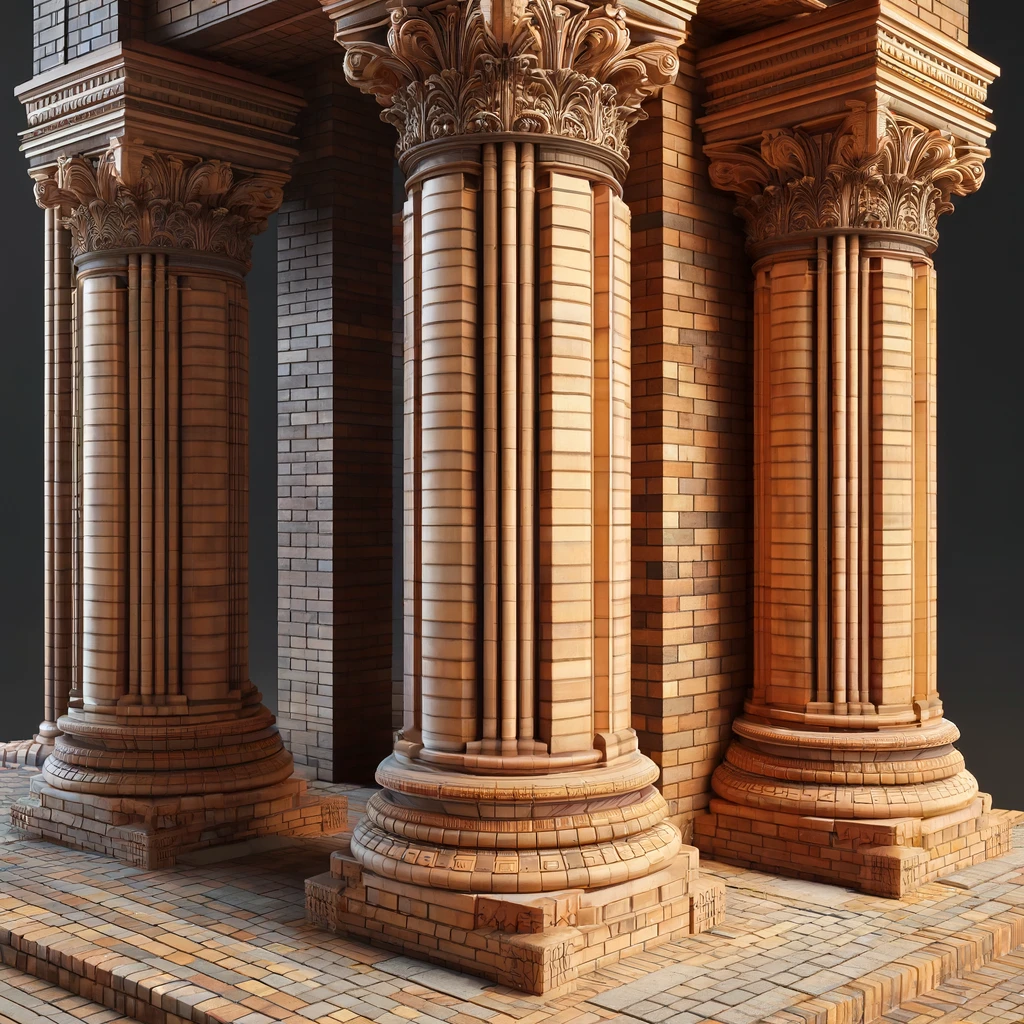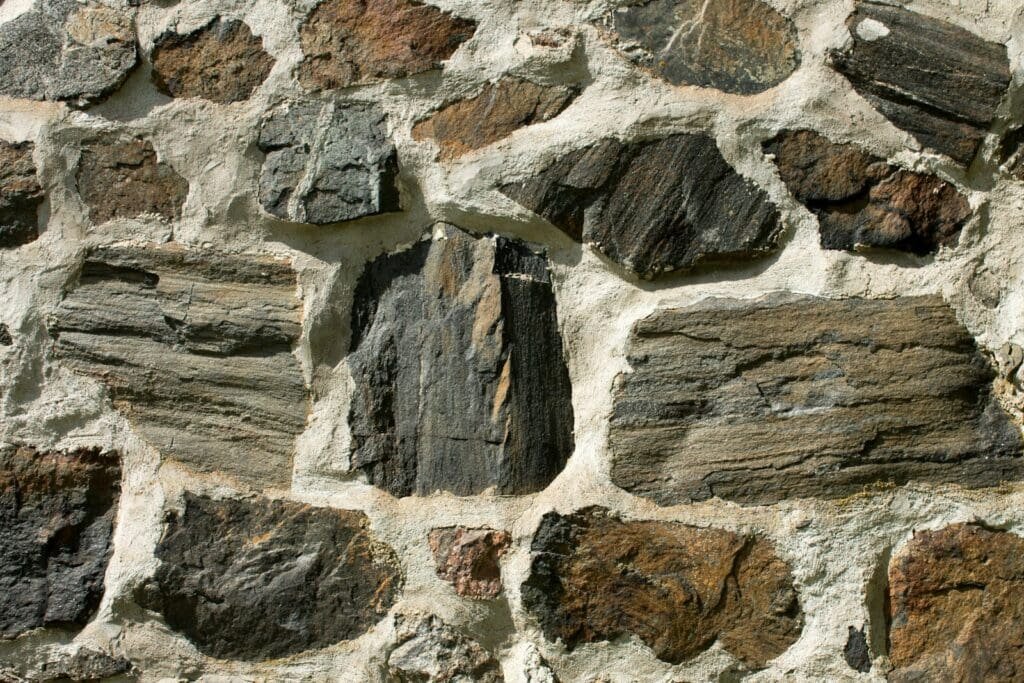Introduction to Understanding Masonry Columns
Have you ever noticed the vertical architectural elements in buildings that sometimes steal the show with their elegance and style?
These are masonry columns.
Let’s explore the world of masonry columns, those steadfast structures that combine beauty and strength in construction.
We will look at their definition, the various types with their characteristics, and the materials typically used in their creation. We’ll also explain the construction process with a step-by-step guide and highlight some notable places where you might find these columns.
Whether you’re a construction enthusiast or just curious about architectural design, there’s something here for everyone. It’s not just bricks and mortar – there’s a slice of history, a hint of art, and plenty of compelling facts.
Let’s begin!
Table of Contents
Understanding Masonry Columns

Definition of Masonry Columns
Masonry columns are vertical structural elements made from individual units such as bricks, stones, or concrete blocks, which are bound together by mortar. They serve both functional and aesthetic purposes in construction.
Types of Masonry Columns
There are several types of masonry columns, each with its characteristics and uses:
- Solid Masonry Columns: These are constructed entirely out of masonry units like bricks or stones.
- Composite Masonry Columns: These columns incorporate other materials, such as steel or concrete, into the masonry construction for added strength.
- Reinforced Masonry Columns: In these columns, internal reinforcement, usually steel bars, is used to enhance the load-bearing capacity.
Materials Used in Masonry Columns
Masonry columns can be made from:
- Bricks: Commonly used due to their versatility and ease of use.
- Stones: Often chosen for their aesthetic appeal and durability.
- Concrete Blocks: Known for their strength and fire resistance.
Construction Process of Masonry Columns
The construction involves several key steps:
| Step | Description |
|---|---|
| 1 | Foundation Preparation: Ensuring a solid base for the column starts with a strong foundation. |
| 2 | Layout: Marking the column dimensions on the foundation. |
| 3 | Material Preparation: Gathering and preparing necessary masonry units and mortar. |
| 4 | Construction: Laying bricks, stones, or blocks layer by layer, ensuring alignment and leveling. |
| 5 | Reinforcement: Adding steel bars if the column is to be reinforced. |
| 6 | Curing: Allowing the mortar to set and gain strength. |
Common Uses of Masonry Columns
Masonry columns can be found in a variety of settings, including:
- Structural Support: Providing load-bearing support in buildings and bridges.
- Ornamental Purposes: Enhancing the visual appeal of buildings, particularly in classical and historic architecture.
- Boundary Markers: Defining property lines and entryways.
Advantages of Masonry Columns
Some of the key benefits include:
- Durability: Resistant to fire, weather, and pests.
- Low Maintenance: Requires minimal upkeep compared to other types of columns.
- Aesthetic Flexibility: Allows for various design options and finishes.
For more detailed information, you can check out Quora’s guide on reinforced masonry columns.
Exploring Masonry in Construction

Masonry Basics
At its core, masonry is a construction technique that involves the assembly of individual units, such as bricks, stones, or concrete blocks, which are glued together with mortar. It is an age-old practice with a rich history, traditionally revered for its strength and durability.
Key Components of Masonry
Here, we explore the integral aspects of masonry:
- Masonry Units: These refer to the individual components – bricks, stones, or concrete blocks – that are pieced together in a masonry construction.
- Mortar: This is the binding agent that joins the masonry units together. Made of a mixture of sand, cement, lime, and water, it solidifies to strengthen the structure.
- Masonry Construction: This is the act of building a structure by aligning individual masonry units and bonding them together with mortar.
Categories of Masonry
Masonry can be broadly classified into stone masonry and brick masonry, depending on the type of material used:
- Stone Masonry: Involves the use of natural stones in constructing structures. Stone masonry is known for its architectural style and elegance.
- Brick Masonry: Utilizes bricks as the main building units. Brick masonry is admired for its longevity and fire resistance.
Notable Attributes of Masonry
Beyond the obvious construct utility, masonry also boasts a wealth of features:
| Attributes | Advantages |
|---|---|
| Resistance to Fire: | Masonry units do not catch fire easily, making them a safer choice for construction. |
| Sound Insulation: | Masonry offers effective soundproofing, reducing noise pollution in residential and commercial buildings. |
| Energy Efficiency: | Brick and stone have a high thermal mass, reducing heat loss and contributing to energy efficiency. |
| Eco-Friendliness: | Masonry materials like stone are usually locally available, minimizing the carbon footprint caused due to transportation. |
| Versatility: | Thanks to a wide range of masonry units available, the possibilities of design and creativity are immense. |
For comprehensive insights into the world of masonry, consider visiting Wikipedia’s detailed entry on masonry.
What is a Building Column?
Definition of Building Columns
A building column is a vertical structural element that primarily acts to support compressive loads. These columns transfer the weight from the roof and upper floors to the foundation below, ensuring the building’s integrity and stability. They can be made from various materials, including wood, steel, concrete, and masonry, depending on the structure and design requirements.
Types of Building Columns
Building columns can be categorized into several types, each with distinct properties and uses:
- Concrete Columns: Commonly used in modern construction due to their strength and durability. They can be either reinforced or pre-stressed.
- Steel Columns: Known for their high strength-to-weight ratio and flexibility. They are often used in high-rise buildings and industrial structures.
- Wooden Columns: Typically used in residential construction and smaller buildings. They provide a balance of load-bearing capacity and aesthetic appeal.
Materials Used in Building Columns
Building columns can be constructed with various materials, each selected based on the specific needs of the structure:
- Concrete: Offers excellent load-bearing capabilities and can be molded into various shapes.
- Steel: Provides significant strength and flexibility, ideal for withstanding dynamic loads and forces.
- Wood: A traditional material used for its availability and ease of use, often seen in residential buildings.
- Masonry: Includes bricks, stones, and concrete blocks. It offers both structural support and aesthetic qualities.
Construction Process of Building Columns
Building columns are constructed through a detailed process that ensures their strength and reliability:
| Step | Description |
|---|---|
| 1 | Planning and Design: Determining the column’s location, size, and material based on architectural and engineering requirements. |
| 2 | Foundation Preparation: Creating a solid base to support the column’s load. This often involves concrete footing. |
| 3 | Column Formwork: Constructing a mold to shape and support the concrete until it hardens. |
| 4 | Material Placement: Installing reinforcement bars if necessary and pouring or assembling the column material. |
| 5 | Concrete Curing: If using concrete, allowing it to cure and gain full strength over a period of days or weeks. |
| 6 | Finishing: Removing the formwork and finishing the column surface as required. |
Common Uses of Building Columns
Building columns have various applications across different types of structures:
- Structural Support: The primary purpose, providing essential support to hold up roofs, floors, and other building elements.
- Architectural Elements: Often used in historic and classical architecture to enhance the aesthetic appeal of buildings through ornate designs.
- Industrial Buildings: Supporting heavy loads such as machinery and equipment used in manufacturing and storage facilities.
Advantages of Building Columns
There are several benefits to using columns in construction:
- Load Distribution: Efficiently transfers the weight of the structure to the foundation, preventing structural stress and failure.
- Design Versatility: Can be tailored to different architectural styles and functional requirements.
- Space Optimization: Allows architects to design open floor spaces without the need for numerous supporting walls.
For further reading, consider checking out Wikipedia’s article on columns.
What is Considered Structural Masonry?
Structural masonry is a construction technique that utilizes masonry units, such as bricks, stones, or concrete blocks, to create a load-bearing structure. This method has been utilized for centuries due to its strength, durability, and versatility.
Key Elements of Structural Masonry
Structural masonry incorporates several critical components:
- Masonry Units: Bricks, stones, or concrete blocks that form the physical structure.
- Mortar: A binding agent made from a mixture of sand, cement, lime, and water. It solidifies to hold masonry units together.
- Reinforcement: Steel bars or mesh that provide additional strength and stability when used in reinforced masonry.
Types of Structural Masonry
There are different variations of structural masonry, each designed to meet specific needs:
- Unreinforced Masonry: Relies solely on the arrangement and strength of the masonry units and mortar without any additional reinforcement.
- Reinforced Masonry: Combines masonry units with internal steel reinforcements to enhance load-bearing capacity and resistance to tensile stresses.
- Post-tensioned Masonry: Involves applying tension to the steel reinforcements after the masonry has been laid, further boosting structural integrity.
Applications of Structural Masonry
Structural masonry is employed in various construction scenarios:
- Residential Buildings: Houses and apartment complexes often use masonry for walls and supporting structures due to its durability and aesthetic appeal.
- Commercial Structures: Shopping centers, office buildings, and hotels benefit from the strength and fire-resistant properties of masonry.
- Industrial Facilities: Warehouses and factories frequently utilize masonry for both structural support and exterior walls.
- Public Infrastructure: Schools, hospitals, and government buildings use masonry for its robustness and longevity.
Advantages of Structural Masonry
Structural masonry offers several benefits making it a preferred construction method:
- Durability: Masonry structures can withstand significant environmental stress, making them highly durable.
- Thermal Insulation: Masonry provides good thermal mass, which helps in regulating building temperatures and conserving energy.
- Fire Resistance: Masonry materials are non-combustible, offering superior fire resistance.
- Low Maintenance: Compared to other construction materials, masonry requires minimal upkeep over extended periods.
- Sound Insulation: Masonry walls offer excellent soundproofing qualities, reducing noise transmission.
Coding Standards and Regulations
The construction of structural masonry is governed by various building codes and standards to ensure safety and structural integrity:
- The International Building Code (IBC): Provides guidelines on the design and construction of masonry structures.
- The ACI 530/ASCE 5/TMS 402: These are standards specific to masonry structures, detailing material specifications, construction methodologies, and design requirements.
Structural masonry is a trusted, reliable construction method that offers strength, resilience, and versatility, making it a valuable choice for a wide range of building applications. For more in-depth information on structural masonry, visiting the Masonry Construction’s website can provide comprehensive insights and updates on industry practices.
Conclusion On Masonry Columns
In essence, masonry columns, along with other types of building columns, are critical structural elements in construction, providing both functional and aesthetic benefits.
These columns can be of various types, including solid, composite, and reinforced masonry columns, and are crafted with diverse materials like bricks, stones, or concrete blocks. The construction process is intricate, involving steps like foundation preparation, layout, material preparation, and construction.
Structural masonry is a traditional construction technique that brings together individual masonry units through the bonding power of mortar, showcasing usability in various settings such as residences, commercial and industrial structures, and public infrastructure. The technique’s unmatched durability, fire resistance, and other inherent features make it a popular choice in construction.
Frequently Asked Questions – FAQs
What are masonry columns?
Masonry columns are vertical structural components constructed using individual units like bricks, stones, or concrete blocks, which are bonded together by mortar. They serve both functional and aesthetic purposes in construction.
What is the purpose of masonry columns?
Masonry columns provide critical structural support in buildings, helping to distribute loads and ensure the structure’s stability and safety. Additionally, they enhance the aesthetic appeal, especially in classical architecture.
What are the types of masonry columns?
Masonry columns can be of various types, like solid masonry columns, composed entirely of masonry units, composite masonry columns, incorporating other materials for added strength, and reinforced masonry columns, featuring internal reinforcement usually comprising steel bars.
What is structural masonry?
Structural masonry is a construction technique that uses masonry units, such as bricks, stones, or concrete blocks, bound together by mortar, to create load-bearing structures. It is known for its strength, versatility, and resilience.
What are the applications of structural masonry?
Structural masonry finds applications in a variety of settings, including residential buildings, commercial structures, industrial facilities, and public infrastructure, thanks to its durability, thermal insulation, fire resistance, and low maintenance requirements.






